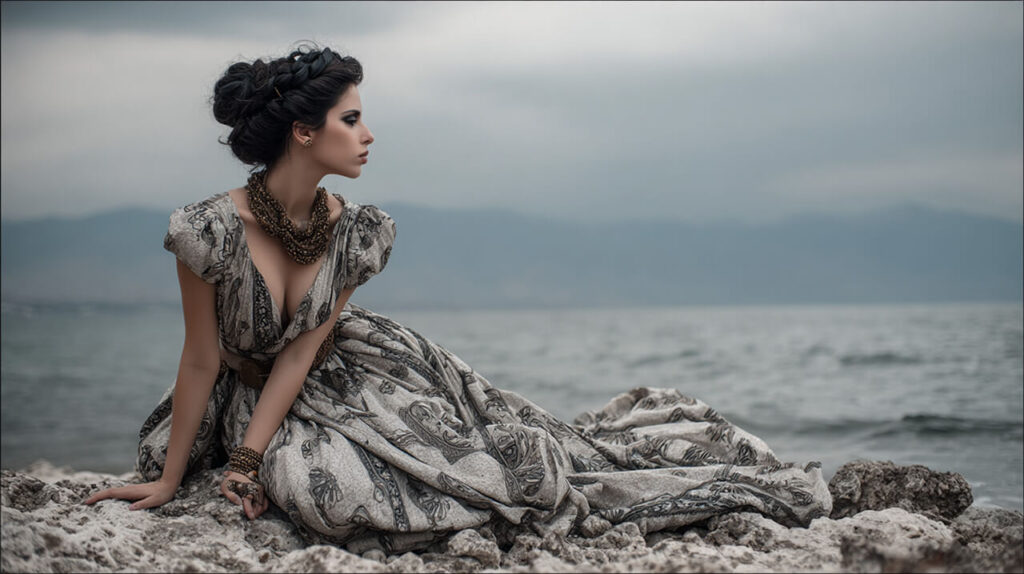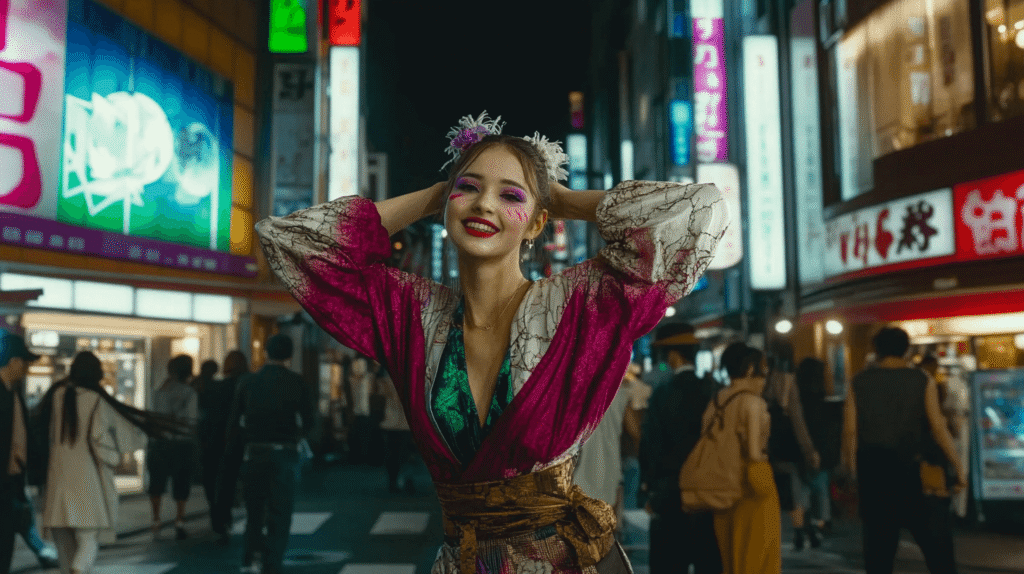Dressing the Past
Phrasal Verbs That Shaped Historical Identities
This page follows the APA Method – Acquire, Practice, Apply, and it’s structured into 5 learning sessions:
🎧 Session 1 – Comprehension
Watch two videos: a podcast episode for context and a shadowing video to practice pronunciation and intonation.
📚 Session 2 – Phrasal Verb Dictionary
Explore the key phrasal verbs used on this page. Each one comes with definitions and clear usage examples.
🧠 Session 3 – Contextual Reading
Read a narrative text where the phrasal verbs are highlighted in context to help you understand how they work naturally.
✅ Session 4 – Application
Test your knowledge through focused exercises. Just click the button below to get started.
❓ Session 5 – Text Comprehension
Answer guided questions based on the reading, improving your understanding and reading skills.
🎧Hit play and watch phrasal verbs come alive in real-life
Fashion & Identity – Phrasal Verbs in Context
This episode is for beginner and intermediate learners. It explores how fashion and identity are connected across time — from traditional clothing to digital fashion — and how these changes reflect social, economic, and personal transformation.
Fashion & Identity – Podcast (Intermediate to Advanced)
This episode brings a podcast-style conversation with natural pace and rich vocabulary. It discusses how fashion, identity and technology intersect, helping learners improve their listening and cultural understanding.
Dress the Past – Shadowing Practice (All Levels)
Practice your English pronunciation and fluency through shadowing. This episode uses short, real sentences about fashion, transportation and communication — perfect for speaking rhythm and repetition.
PHRASAL VERBS DICTIONARY
LOOKING FOR EXERCISES
Click the button below to test what you already know about phrasal verbs.
Once you’ve finished studying, come back and retake the exercises to measure your progress!
👇
Here we'll explore three important aspects of everyday life, using phrasal verbs expressed in the past tense
Welcome to “Phrasal Verbs Through Time”!
👉 Click on the blue words to navigate to the pages related to each topic or timeframe.
On this page, we’ll explore three essential aspects of daily life—communication, transportation, and fashion—using common phrasal verbs expressed in the past tense.
This content is part of a broader session where we discuss frequently used phrasal verbs related to these topics in different verb tenses. While here you’ll find examples and reflections expressed in the present, we also invite you to explore similar texts set in the present and future tenses.
PAST TENSE
Fashion Evolution
Changes in Clothing Models Over Time
Throughout history, clothing has served as much more than mere protection from the elements. Fashion has always been a powerful tool for social communication, and the way people dress has continuously evolved, reflecting broader changes in society, technology, and cultural values. As we look back (reflect / remember) at the evolution of fashion, we can observe how clothing models have transformed dramatically over the centuries.
📚 PHRASAL VERB SPOTLIGHT: LOOK BACK
Meaning: To think about or remember past events
Structure: LOOK + BACK (inseparable)
Usage Examples:
• “As we look back at fashion history, we see clear patterns” (remember/review)
• “She always looks back on her childhood fondly” (remember with emotion)
Common Mistakes: Don’t confuse with “look behind” (physical action) or “look up” (search for information)
Clothing and Social Status: A Historical Connection
The relationship between vestments and social status has been a defining characteristic of fashion throughout the ages. In medieval times, sumptuary laws would set apart (distinguish) different social classes through strict dress codes. The aristocracy would show off (brag) their wealth through elaborate fabrics, intricate embroidery, and expensive accessories that common people could never afford.
📚 PHRASAL VERB SPOTLIGHT: CATCH ON
Meaning: To become popular or widely accepted
Structure: CATCH + ON (inseparable)
Usage Examples:
• “Ready-to-wear clothing started to catch on among consumers” (become popular)
• “The new trend didn’t catch on in rural areas” (become accepted)
Common Mistakes: Don’t confuse with “catch up” (reach the same level) or “catch out” (discover wrongdoing).

During the Renaissance, fashion began to take on (accept) new meanings as trade routes expanded and new materials became available. The wealthy would dress up (wear nice clothes) in silk and velvet imported from distant lands, while the working class had to make do (manage) with locally produced wool and linen. This clear distinction helped to keep up (maintain) the social hierarchy that defined these societies.
📚 PHRASAL VERB SPOTLIGHT: SHOW OFF
Meaning: To display something proudly or to boast about something
Structure: SHOW + OFF (separable)
Usage Examples:
• “The aristocracy would show off their wealth through clothing” (display proudly)
• “He likes to show off his new car” (boast about)
Common Mistakes: Don’t confuse with “show up” (arrive) or “show around” (give a tour)
The Industrial Revolution and Fashion Democratization
The Industrial Revolution began to break down (collapse) many traditional barriers in fashion. Mass production techniques started to bring down (reduce / depress) the cost of clothing, making fashionable items more accessible to the growing middle class. Department stores began to spring up (appear quickly) in major cities, and ready-to-wear clothing started to catch on (become popular) among consumers who had previously relied on custom-made garments.
However, the upper classes were reluctant to give up (quit) their fashion privileges. They would turn to (rely on) haute couture houses that began to set up (establish) in Paris and other fashion capitals. These exclusive establishments would come up with (invent / create) innovative designs that would help the elite stand out (be noticeable) from the increasingly well-dressed masses.
📚 PHRASAL VERB SPOTLIGHT: CATCH ON
Meaning: To become popular or widely accepted
Structure: CATCH + ON (inseparable)
Usage Examples:
• “Ready-to-wear clothing started to catch on among consumers” (become popular)
• “The new trend didn’t catch on in rural areas” (become accepted)
Common Mistakes: Don’t confuse with “catch up” (reach the same level) or “catch out” (discover wrongdoing)


Modern Standardization and Cultural Homogenization

The 20th and 21st centuries have witnessed an unprecedented process of fashion standardization that has begun to wipe out (destroy) many traditional forms of dress. Global fashion brands have managed to take over (assume control) local markets, and international fashion trends now spread out (expand) rapidly across the world through social media and mass communication.
This globalization of fashion has led many traditional clothing styles to die out (go extinct) or become relegated to special occasions only. Young people in many cultures are increasingly moving away from (leaving behind) their traditional dress codes and taking up (starting) Western-style clothing. While this trend has helped to bring together (unite) people from different cultures, it has also contributed to the gradual fading away (disappearing) of distinctive cultural identities expressed through clothing.
📚 PHRASAL VERB SPOTLIGHT: TAKE OVER
Meaning: To gain control of something or replace something/someone
Structure: TAKE + OVER (separable)
Usage Examples:
• “Global fashion brands have managed to take over local markets” (gain control)
• “Technology will take over many traditional jobs” (replace)
Common Mistakes: Don’t confuse with “take on” (accept responsibility) or “take off” (remove/depart)
The Loss of Identity Through Fashion Standardization
As multinational fashion corporations continue to expand into (grow into) new markets, traditional clothing manufacturers often cannot keep up with (stay current) the competition. Local artisans who have been carrying on (continuing) ancestral techniques for generations are finding it increasingly difficult to hold on to (keep) their customer base. Many traditional clothing styles that once helped communities tell apart (differentiate) different regions or social groups are now slowly disappearing into (vanishing) obscurity.
The standardization process has also led to what some scholars refer to as “fashion monoculture.” Shopping malls around the world now look alike (resemble), filled with the same international brands that put out(release / extinguish) similar collections season after season. This homogenization has made it increasingly difficult for individuals to express themselves through unique clothing choices, as the available options become more and more standardized.
📚 PHRASAL VERB SPOTLIGHT: DIE OUT
Meaning: To disappear gradually or become extinct
Structure: DIE + OUT (inseparable)
Usage Examples:
• “Traditional clothing styles are beginning to die out” (disappear gradually)
• “Many ancient languages have died out over time” (become extinct)
Common Mistakes: Don’t confuse with “die down” (become less intense) or “die off” (die in large numbers)

Contemporary Resistance and Revival Movements
Despite the overwhelming trend toward standardization, some groups are beginning to push back against (resist) fashion homogenization. Cultural preservation movements are working torevive traditional clothing styles and bring back (return) ancient techniques that were almost lost. These initiatives are trying to build up (increase) awareness about the importance of cultural diversity in fashion.
Some fashion designers are also reaching out to (contact) traditional artisans and teaming up with (collaborate) them to create contemporary collections that draw on (use) ancestral knowledge. These collaborations help to keep alive (preserve) traditional techniques while adapting them to modern tastes and lifestyles.
The evolution of clothing models over time reflects broader social, economic, and cultural transformations. While fashion has always served as a marker of social status, the recent trend toward standardization has begun to smooth out (resolve / ease) many of the distinctive features that once helped define different cultures and communities. As we move forward (progress), the challenge will be to find ways to balance out (equalize) the benefits of global fashion accessibility with the need to preserve the rich diversity of traditional clothing styles that represent our collective cultural heritage.
📚 PHRASAL VERB SPOTLIGHT: BRING BACK
Meaning: To restore, revive, or return something to a previous state
Structure: BRING + BACK (separable)
Usage Examples:
• “Movements are working to bring back ancient techniques” (restore/revive)
• “This song brings back childhood memories” (causes to remember)
Common Mistakes: Don’t confuse with “bring up” (mention/raise) or “bring about” (cause to happen)
LOOKING FOR EXERCISES
Let’s see your progress!
Now that you’ve studied, retake the exercises and surprise yourself! 👇
Fashion & Identity
🧠 Ready to test your reading skills?
Click on each question below 👇 to reflect on the text and check your understanding in context!
Why did medieval European clothes have many layers?
To show wealth and social status, as heavy and elaborate garments signaled that the wearer didn’t perform manual labor.
How were clothes in Sub-Saharan Africa different from European ones?
They were lighter, more vibrant, practical, and often carried geometric patterns representing tribal identity.
What distorted the global perception of historical clothing?
European colonialism spread a biased view of fashion, overlooking non-European complexities.
What did historians and anthropologists start questioning in the late 20th century?
They questioned the limited, Eurocentric view of fashion history.
Give examples of sophisticated non-European textile traditions.
Indian cashmere fabrics and Ghanaian kente cloth.
